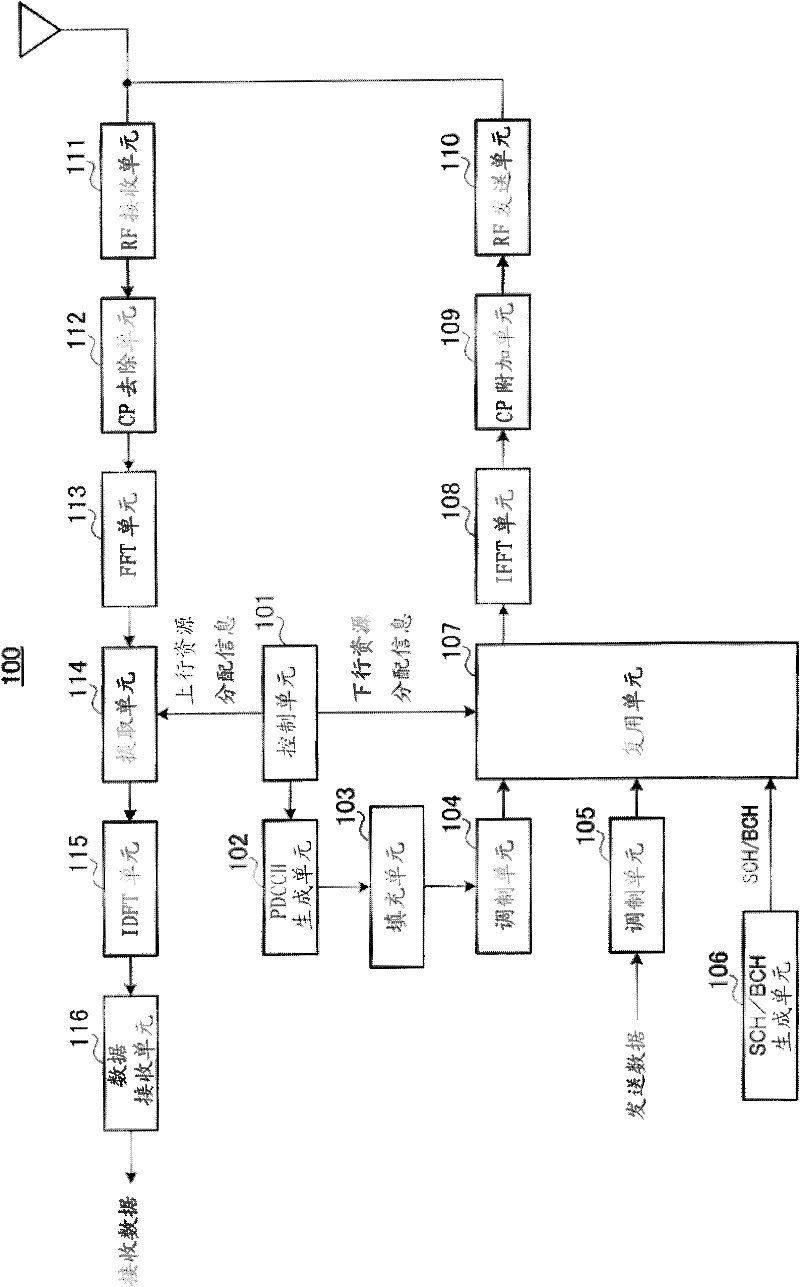Radio terminal device, radio base station device, and channel signal forming method
A wireless terminal, channel signal technology, applied in the direction of wireless communication, transmission path separation device, transmission path sub-channel allocation, etc., to achieve the effect of preventing quality degradation
- Summary
- Abstract
- Description
- Claims
- Application Information
AI Technical Summary
Problems solved by technology
Method used
Image
Examples
Embodiment approach 1
[0043] figure 2 It is a block diagram showing the configuration of base station 100 according to Embodiment 1 of the present invention. exist figure 2 Among them, the base station 100 has a control unit 101, a PDCCH generation unit 102, a padding unit 103, modulation units 104, 105, an SCH / BCH generation unit 106, a multiplexing unit 107, an IFFT unit 108, a CP addition unit 109, an RF transmission unit 110, RF receiving unit 111 , CP removing unit 112 , FFT unit 113 , extracting unit 114 , IDFT unit 115 and data receiving unit 116 . The base station 100 is configured to be able to perform communication using an uplink component frequency band and a plurality of downlink component frequency bands associated with the uplink component frequency band.
[0044] The control unit 101 generates uplink resource allocation information and downlink resource allocation information for the terminal 200 described later, outputs the uplink resource allocation information to the PDCCH ge...
Embodiment approach 2
[0095] When the bandwidth of the uplink component frequency band is the same as that of the downlink component frequency band, sometimes the sizes of the downlink resource allocation information and the uplink resource allocation information are different from each other. The only difference between this embodiment and Embodiment 1 is that at this point.
[0096] That is, in Embodiment 1, it was explained that if the bandwidth of the uplink component frequency band and the bandwidth of the downlink component frequency band are the same, the downlink resource allocation information of the downlink component frequency band in the basic component frequency band has the same information size as the uplink resource allocation information . On the other hand, in this embodiment, when the bandwidth of the uplink component frequency band is the same as that of the downlink component frequency band, the information sizes of the downlink resource allocation information and the uplink re...
Embodiment approach 3
[0119] This embodiment differs from Embodiments 1 and 2 in that the base station variably sets the basic unit frequency band for each terminal.
[0120] That is, in Embodiment 3, the base station sets a basic component frequency band according to the same criteria as in Embodiment 1 or 2 when starting high-speed communication with a certain terminal by carrier aggregation. However, in Embodiment 3, the base station can instruct the terminal to add / change the basic component band at any timing.
[0121] Below, use Figure 5 to Figure 9 Next, each configuration and operation of the base station 300 and the terminal 400 according to Embodiment 3 of the present invention will be specifically described.
[0122] Figure 5 It is a block diagram showing the configuration of base station 300 according to Embodiment 3 of the present invention. and figure 2 Shown in base station 100 compared to the Figure 5 The base station 300 shown has a control unit 301 instead of the control ...
PUM
 Login to View More
Login to View More Abstract
Description
Claims
Application Information
 Login to View More
Login to View More - R&D
- Intellectual Property
- Life Sciences
- Materials
- Tech Scout
- Unparalleled Data Quality
- Higher Quality Content
- 60% Fewer Hallucinations
Browse by: Latest US Patents, China's latest patents, Technical Efficacy Thesaurus, Application Domain, Technology Topic, Popular Technical Reports.
© 2025 PatSnap. All rights reserved.Legal|Privacy policy|Modern Slavery Act Transparency Statement|Sitemap|About US| Contact US: help@patsnap.com



